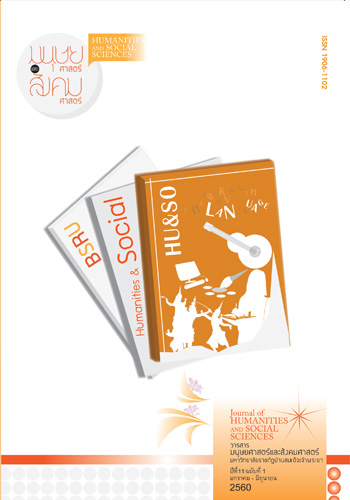Creative Thinking : Teaching Art for Children
Keywords:
Creative Thinking, Imagination, Teaching Art to ChildrenAbstract
It has been widely accepted that creative thinking is important and is what human should have. Numerous psychologists have accepted that human’s creative thinking can create new things, whether objects or processes, which can help solve the problems in life, and a lack of creative thinking will have an opposite effect. It is an innate characteristic and has a clear process of generation, and its starting and ending points are arranged in order and separated from intelligence. It is what needs to be continually trained so that the brain is fluent in thinking. As it cannot be developed in the adulthood, it should be practiced since the childhood because it is the most appropriate age when the brain is able to best learn and reserve things for future competence. We can see that people with creative thinking have many unique characteristics and it might be hard for these characteristics happen naturally without good and continuous practices. Many subjects or courses in the curricula of primary and secondary education are offered for young students to learn in order to get prepared for living in the society when they grow up, and many of which consist of only each side of facts for learning. Thus, most teaching arrangements primarily focus on making students know and remember the facts, not on how to analyze and apply such facts. This teaching approach has no motivation of creative thinking to children regrettably when they are at an appropriate age. However, there are some subjects, such as art, where both core and school-specific curricula clearly specify one of the subject’s purposes as to improve the creative thinking of children based on the understanding that art is a subject that can encourage the young student’s creative thinking and must be encouraged during their childhood. In addition, this subject is most suitable for primary and first-half of secondary educations because it has no exact correctness and incorrectness and no fix pattern to follow. The process of creating an art work is the same process of creative thinking so it is easy to use the art to encourage the creative thinking in childhood. More importantly, children are naturally ready to enjoy their imagination based on art activities, and despite no teacher’s teaching, they create things at home. When they become a high-school student, their boundless imagination starts disappearing and is displaced by learning the facts of life. One of the facts is that art subject is inherently unable to create new things that are useful in the society; rather, it can generate creative people. As this characteristic has still existed until they are adult, it will be applied with higher knowledge in various branches and can then create new things that are useful in the society unlimitedly. Teaching art in the primary and secondary schools should take into account the following three important considerations:
1. Do not focus on actual imitations, whether background, figure or color.
2. Encourage students to use their own imagination as much as possible.
3. Do not score based on similarity, beauty and reality, but on imagination, innovation and uniqueness.
References
เกรียงศักดิ์ เจริญวงศ์ศักดิ์. (2545). การคิดเชิงสร้างสรรค์. กรุงเทพฯ : ซัคเซส มีเดีย.
จันทร์จิรา นที. (2548). ผลการจัดกิจกรรมซินเนคติคส์ที่มีต่อความคิดสร้างสรรค์ของนักศึกษา. วิทยานิพนธ์ปริญญาศึกษาสาสตรมหาบัณฑิต สาขาวิชาเทคโนโลยีทางการศึกษา บัณฑิตวิทยาลัย มหาวิทยาลัยเชียงใหม่.
ปริญญ์ ทนันชัยบุตร. (2553). การพัฒนารูปแบบการจัดการเรียนรู้ทัศนศิลป์เพื่อพัฒนาความคิดสร้างสรรค์. วิทยานิพนธ์ศึกษาศาสตรดุษฎีบัณฑิต สาขาวิชาหลักสูตรและการสอน มหาวิทยาลัยขอนแก่น.
มนูญ ตมะวัฒนา. (2537). จิตวิทยาอุตสาหกรรม. กรุงเทพฯ : ธีระการพิมพ์.
อารี พันธ์มณี. (2537). ฝึกให้คิดเป็น คิดให้สร้างสรรค์. กรุงเทพฯ : ใยไหม เอดดูเคท.
อารี รังสินันท์. (2528). ความคิดสร้างสรรค์. กรุงเทพฯ : แพร่พิทยา.
Guilflord, J.P. and Raph.(1950).The Analysis of Intelligence. New York : McGraw-Hill.
Mason, P.(1960). The Knowledge-Creativity. New York : Cambridge University Press.
Torrance, E.P. and Myers, R.E.(1972). Creative Learning and Teaching. New York : Good Mead and Company.
Torrance, E.P. and Myers, R.E. (1965). What Research Says to the Teachers in Creativity. Washington D.C. : Association of Classroom Teachers of the National Education Association.
Wallach,Micheal A. & Kogan,Nathan. (1965). Model of Thinking in Young Children. New York: Rinchart and Winston.
Downloads
Published
How to Cite
Issue
Section
License

This work is licensed under a Creative Commons Attribution-NonCommercial-NoDerivatives 4.0 International License.



